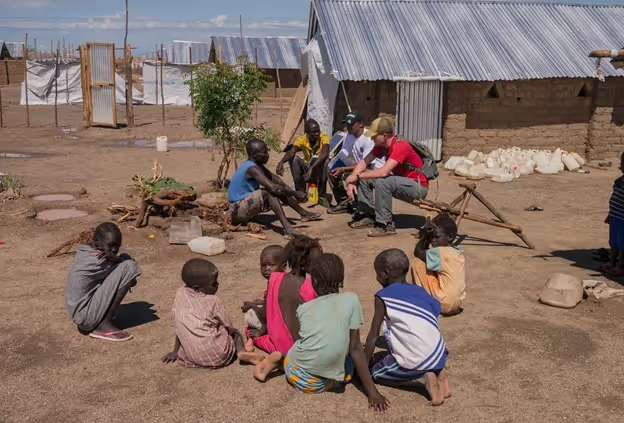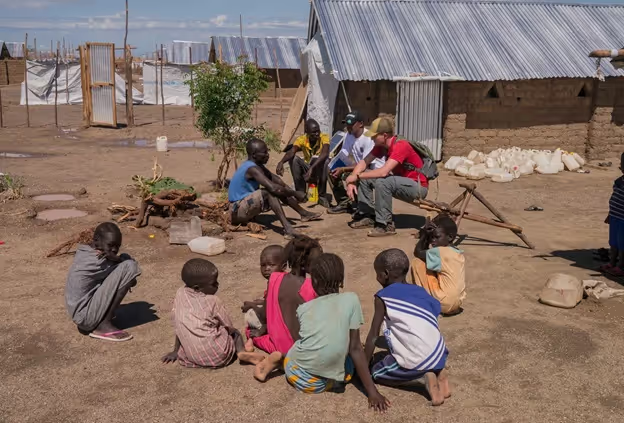Developing a human waste transfer station at Kakuma Refugee Camp

Written by Vadim Kuklov, Product Development Associate, Sanergy
The Context of Kakuma Refugee Camp
Kakuma Refugee Camp is home to 180,000 people, displaced from 14 different countries and settled in arid Turkana County in the northwest of Kenya. The residents live in UN-provided mud-brick homes on SPHERE-standard 6m x 3.5m plots, often organised into small fenced communities within larger blocks. Kakuma is separated into 4 camps by seasonal rivers: bare riverbeds for most of the year that transform overnight into raging torrents which sweep away homes, people, roads, and vehicles during the rainy seasons.
This temporary camp has been open since 1992 and shows no signs of getting smaller as neighbouring countries repeatedly fall back into conflict. For the past two decades, the only solution for fecal sludge management (FSM) in Kakuma has been to dig pit latrines. When these 5-meter deep holes are full of human waste, they are backfilled and a new pit is dug in whatever open space is available. Unfortunately, after 22 years of digging new pits, the camp as a whole, and especially older areas such as Kakuma 1, is simply running out of open space.
The Norwegian Refugee Council (NRC) and UNHCR are now faced with a quandary: finding a FSM system that will replace digging pits and implementing it in a place that has been doing the same thing for decades.
The role of Sanergy
Sanergy, an organisation based in Nairobi which focuses on delivering total hygienic sanitation services, and GOAL are developing a human waste transfer station with support from the Humanitarian Innovation Fund (HIF). A network of these stations in Kakuma camp could consolidate fecal sludge, preparing it to be exhausted by trucks and removed from the community. This sanitation chain would improve the camp residents’ health and eliminate the need to dig new pits.
As the product development team at Sanergy, we travelled to Kakuma in late November to ascertain whether a transfer station could be an appropriate solution to Kakuma’s fecal ills. We wanted to determine what cultural and operational factors of an emergency response would affect the design as we develop the technology, and as disasters are unpredictable and not conducive to research, Kakuma would have to serve as a proxy.
Supported by the UNHCR and NRC, we conducted a week of interviews with everyone from residents to government officials, and performed site visits to different neighbourhoods and institutions within Kakuma. This research provided a wealth of information and insight into the camp’s sanitation situation.

The camp faces the challenges of severe seasonal flooding, wide variety in cultures and hygiene practices, a complete lack of waste collection and treatment infrastructure, as well as a lack of any electricity grid. While there is no clear fix in sight, the NRC is working towards solutions through ongoing pilots. Solving this unique mix of problems will be crucial for any solution to take hold in the camp. At the same time, addressing these issues in our design will also create robustness and flexibility, allowing the waste transfer station to be implemented in different settings around the world.
After witnessing the systemic issues caused by unsustainable sanitation practices, we are even more convinced that a waste transfer station should become part of a well-planned emergency response sanitation chain.
As we move forward, we will continue to gather information and design criteria through field visits and research. Developing this technology is quite a challenge, but success means a valuable tool is added to the repertoire of rapid onset emergency response.
Stay updated
Sign up for our newsletter to receive regular updates on resources, news, and insights like this. Don’t miss out on important information that can help you stay informed and engaged.
Related articles
.png)


Explore Elrha
Learn more about our mission, the organisations we support, and the resources we provide to drive research and innovation in humanitarian response.